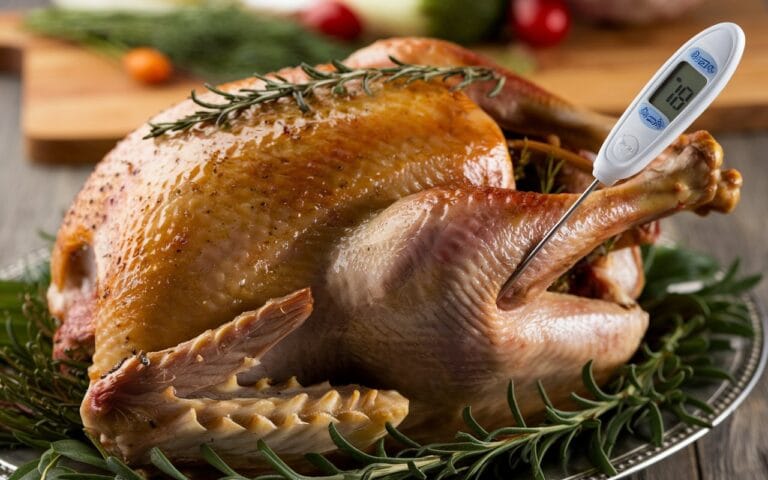Roasting a turkey is a centerpiece of many holiday feasts, but achieving the perfect balance between juicy meat and crispy skin can be a challenge. One of the most critical factors in getting it right is choosing the ideal temperature to roast your turkey. Should you go for a slow roast at 325°F for more tender meat or opt for the faster, crispy approach at 350°F? In this comprehensive guide, we’ll break down the pros and cons of different turkey roasting temperatures and provide expert tips to help you nail your next roast.
The Importance of Roasting Temperature
Before diving into the details, it’s important to understand why roasting temperature matters. The temperature you choose will directly affect the:
- Texture: Low temperatures result in tender, juicy meat, while higher temperatures yield a crispier exterior.
- Cooking time: Roasting at higher temperatures shortens the cooking time, while lower temperatures extend it.
- Moisture: Lower temperatures help retain moisture, while higher temperatures risk drying out the turkey.
Choosing the right roasting temperature depends on your priorities for texture, moisture, and cooking time.
Roasting at 325°F: Slow and Steady
Roasting a turkey at 325°F is the traditional slow and steady method. This lower temperature allows the bird to cook evenly, and it’s perfect for larger turkeys that require more time in the oven. If your priority is moisture retention and even cooking, this temperature might be the best choice.
Pros of Roasting at 325°F:
- Even cooking: The lower temperature ensures the bird cooks thoroughly without overcooking the outside.
- Juicy meat: Slow roasting at 325°F allows the meat to retain more moisture, resulting in tender, flavorful turkey.
- Lower risk of burning: At 325°F, you have less risk of burning the skin or drying out the breast meat.
Cons:
- Longer cooking time: Roasting at 325°F takes longer, which may be inconvenient if you’re preparing other dishes.
- Softer skin: If crispy skin is a priority, 325°F might not give you the desired texture.
Estimated cooking time: Approximately 15-17 minutes per pound for an unstuffed turkey.
Roasting at 350°F: Faster with Crispier Skin
For those who want to shorten cooking time while still achieving a golden-brown, crispy skin, roasting at 350°F is a popular option. This higher temperature allows you to roast the turkey more quickly, which is ideal if you’re short on time.
Pros of Roasting at 350°F:
- Crispy skin: The higher heat promotes a golden, crispy exterior, which many people prefer.
- Faster cooking time: Roasting at 350°F reduces the overall cooking time, which is perfect for busy holiday preparations.
Cons:
- Drying out risk: Cooking at a higher temperature can cause the breast meat to dry out more quickly if not monitored carefully.
- Less even cooking: While the skin crisps up nicely, the inside of the bird might not cook as evenly as it would at a lower temperature.
Estimated cooking time: 13-15 minutes per pound for an unstuffed turkey.
If you are aiming for crispy skin and don’t mind keeping an eye on the turkey to avoid drying it out, 350°F is your best bet.
Roasting at 400°F or Higher: Quick and Crisp
Roasting at 400°F or even higher might seem unusual, but for smaller turkeys or those who love an extra-crispy skin, it can be an excellent choice. The high heat ensures a crispy exterior and significantly reduces cooking time. However, it comes with some risks.
Pros:
- Ultra-crispy skin: The high temperature quickly crisps up the skin.
- Fast roasting time: Perfect for those in a hurry, roasting at 400°F cuts down the time in the oven.
Cons:
- Dry meat: The high temperature can dry out the meat, especially the breast. Constant monitoring is essential.
- Requires more basting: To maintain moisture, you’ll need to baste the turkey more frequently.
The Combination Method: Best of Both Worlds
If you’re looking for crispy skin but still want tender, juicy meat, the combination method is a great solution. This technique involves starting the turkey at a high temperature and then lowering it to cook more evenly.
How It Works:
- Start at 425°F: Roast the turkey at a high temperature for the first 30-45 minutes. This will help to crisp the skin early on.
- Lower to 325°F: After the initial high-heat phase, reduce the oven temperature to 325°F for the remainder of the cooking time. This ensures the meat cooks evenly without drying out.
This method provides the best of both worlds: a crispy exterior and moist, tender meat inside.
Choosing the Right Temperature Based on Turkey Size
The size of your turkey also plays a crucial role in determining the roasting temperature. Larger birds benefit from a lower roasting temperature to ensure the meat cooks through without overcooking the outside. Smaller turkeys can be roasted at higher temperatures since they cook faster and more evenly.
Factors to Consider:
- Larger turkeys (15+ lbs): A slower roast at 325°F will yield better results for even cooking and moisture retention.
- Smaller turkeys (under 15 lbs): These can handle higher temperatures, such as 350°F or even 400°F, without risking uneven cooking.
Roasting Time by Weight and Temperature
Here’s a helpful chart to determine how long to roast your turkey based on its weight and the chosen temperature:
| Turkey Weight | 325°F Cooking Time | 350°F Cooking Time |
|---|---|---|
| 8-12 lbs | 2.5 – 3 hours | 2.25 – 2.75 hours |
| 12-14 lbs | 3 – 3.5 hours | 2.75 – 3 hours |
| 14-18 lbs | 3.5 – 4.25 hours | 3 – 3.75 hours |
| 18-20 lbs | 4.25 – 4.5 hours | 3.75 – 4.5 hours |
| 20-24 lbs | 4.5 – 5 hours | 4.5 – 5 hours |
For stuffed turkeys, add 15 minutes per pound to these times to ensure the stuffing reaches a safe internal temperature of 165°F.
Essential Tips for Roasting a Turkey
Basting for Moisture
Basting is key to keeping the turkey moist, especially when using higher temperatures. Baste the turkey every 30-40 minutes with its own juices or melted butter.
Using a Meat Thermometer
A meat thermometer is your best friend when roasting a turkey. To ensure it’s safe to eat, the turkey needs to reach an internal temperature of 165°F. Insert the thermometer into the thickest part of the breast and thigh, avoiding bone.
Let the Turkey Rest
Once the turkey is out of the oven, let it rest for 20-30 minutes before carving. This allows the juices to redistribute, ensuring each slice is moist and flavorful.
FAQs
What temperature should a turkey be cooked to?
The internal temperature should reach 165°F in the thickest part of the breast and thigh to ensure it’s safe to eat.
Is it better to cook a turkey at 325 or 350?
325°F results in more even cooking and moisture retention, while 350°F gives you a crisper skin with a shorter cooking time.
Can you cook a turkey at 400 degrees?
Yes, roasting at 400°F can be a fast option, but it requires careful monitoring to prevent the meat from drying out.
Conclusion
The temperature at which you roast your turkey will impact its texture, moisture, and overall flavor. While 325°F offers a more traditional approach with moist, even cooking, 350°F gives you crispy skin and faster results. The combination method is an excellent option if you want both crispy skin and tender, juicy meat.
Whichever method you choose, remember to use a meat thermometer to ensure your turkey reaches the proper internal temperature of 165°F. By following these tips, you’ll be well on your way to preparing the perfect roast turkey for your next holiday gathering!
Print
What temperature do you roast a turkey at?
Roasting a turkey is a centerpiece of many holiday feasts, but achieving the perfect balance between juicy meat and crispy skin can be a challenge. One of the most critical factors in getting it right is choosing the ideal temperature to roast your turkey. Should you go for a slow roast at 325°F for more tender meat or opt for the faster, crispy approach at 350°F? In this comprehensive guide, we’ll break down the pros and cons of different turkey roasting temperatures and provide expert tips to help you nail your next roast.
- Total Time: 40 minute
- Yield: 8-10 servings 1x
Ingredients
- 1 whole turkey (12–15 pounds)
- 1/2 cup softened butter
- 2 tablespoons olive oil
- Salt and pepper (to taste)
- Fresh herbs (rosemary, thyme, sage)
- 4 garlic cloves, minced (optional)
- 1 lemon, quartered (optional)
- 1 onion, quartered (optional)
- 1 cup chicken broth or water (for basting)
Instructions
- Preheat the Oven:
Preheat your oven to 325°F or 350°F depending on your preferred roasting method. - Prepare the Turkey:
Remove the giblets and pat the turkey dry with paper towels. Rub the softened butter and olive oil all over the turkey, then season generously with salt, pepper, and fresh herbs. Optionally, stuff the cavity with garlic, lemon, and onion for added flavor. - Truss the Turkey:
Tie the turkey’s legs together using kitchen twine, which will help it cook evenly. - Place in Roasting Pan:
Place the turkey on a rack in a large roasting pan. Pour the chicken broth or water into the bottom of the pan to keep the turkey moist during roasting. - Roast the Turkey:
- For 325°F: Roast the turkey for 15-17 minutes per pound.
- For 350°F: Roast the turkey for 13-15 minutes per pound. Tip: If the skin starts browning too quickly, tent the breast with foil after the first hour.
- Check the Temperature:
Use a meat thermometer to ensure the thickest part of the breast and thigh reaches an internal temperature of 165°F. - Rest the Turkey:
Let the turkey rest for 20-30 minutes before carving. This allows the juices to redistribute, resulting in moist, flavorful meat.
- Prep Time: 20 minutes
- Cook Time: 2.5 to 4.5 hours (depending on size and temperature)
- Category: Main Course
- Method: Roasting
- Cuisine: American
- Diet: Gluten Free
Keywords: roast turkey, turkey roasting, holiday turkey, Thanksgiving turkey, crispy skin turkey, juicy turkey, perfect turkey recipe




